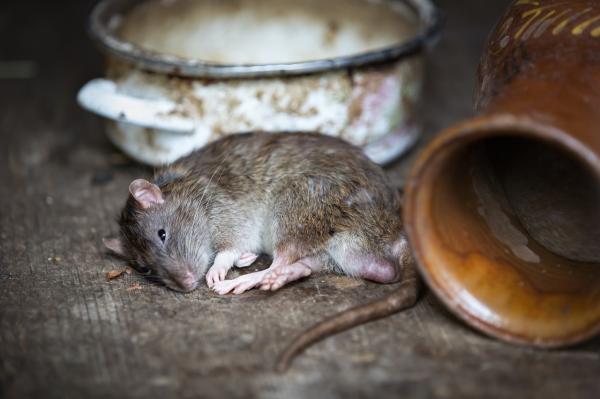My Pet Rat Is Not Moving


As with all companion animals, rats need a certain level of care to maintain optimal health. Providing a balanced diet, suitable accommodation and taking them to the veterinarian for regular checkups help provide their basic care needs. However, even with careful consideration of these needs, a rat can become ill or suffer from a health problem which threatens their well-being and, potentially, their life. One of the most worrying signs is when you see your pet rat is no longer moving.
At AnimalWised, we understand why my pet rat isn't moving anymore. We look at the 6 main causes of this state and what we can do to help them.
They are sleeping
Rats are nocturnal animals, so it is common to see them sleeping for much of the day. They can sleep for long periods, often up to 4 hours or more. In principle, if we see our rat is not moving and their eyes are closed, it may be they are merely asleep. You can tell your rat is sleeping if they adopt one of the following positions:
- Ball-shaped: when they are alone, they usually sleep with their head between their legs forming a kind of ball. They do this to maintain body temperature.
- Stretched out: when the ambient temperature is high, they often stretch out completely to sleep. In doing so, they maximize their contact with the ground's surface and can cool down more easily.
- In a group: when we have more than one pet rat living together, it is common for them to snuggle together to sleep and maintain their body temperature.
Sleep as a symptom of illness
If you find your pet rat remains immobile for a long time, you may suspect something is wrong. You may see other symptoms of illness or know they have experienced a trauma. In these cases, lethargy might be a symptom of a pathology. An accompanying symptom which is important to be observant of is chromodacryorrhea. This is known as ‘bloody tears’ as we can see the rat has a reddish-orange discharge from their tear ducts. This indicates the rat has a lowered immune system and may not have the energy to get up.
To know if a rat is suffering rather than merely sleeping, we need to consider the following:
- They do not move because they have a decreased level of consciousness (lethargy or stupor). You will know it because the rat is in a deep sleep state. They are slow to respond to stimuli or, in severe cases, do not respond to stimuli of any kind.
- Despite being alert (with a normal level of consciousness), they do not move, move less or move with greater difficulty. In this case, the immobility may be due to paralysis of their limbs or pain due to trauma.
When a they do not respond at all and their breathing is very slow, it is a sign the rat is dying. Whether or not their death is preventable will depend on the cause and treatment options available. Below we look at these in more detail.
Digestive pathologies
The most common digestive disorders in rats are usually caused by intestinal parasites (protozoa and nematodes) or bacterial infections (such as salmonellosis). These processes can occur asymptomatically, but can also cause severe diarrhea. In turn, this can lead to weight loss and lethargy in rats. If you detect that your pet rat has stopped moving and they are accompanied by digestive signs, the cause is most likely an infection or intestinal parasites.
Internal parasites can come from inappropriate food. Take a look at our article on what to feed a rat so you can avoid dietary problems.
Respiratory pathologies
Murine respiratory mycoplasmosis (MRM) is a respiratory disease caused by a bacterial infection, specifically by the pathogen Mycoplasma pulmonis. Rats that suffer from this infection, in addition to presenting respiratory signs such as sneezing, runny nose and respiratory distress, can also present general clinical signs such as lethargy, coat deterioration, loss of appetite and weight loss.
In addition to Mycoplasma, there are other bacteria and viruses capable of causing respiratory infections in rats which lead to similar symptoms. In addition to Not moving, if you detect that your pet rat has signs of respiratory problems, the most likely cause is a respiratory infection.
Spinal pathologies
Degenerative pathologies of the spinal cord can cause weakness (paresis) or paralysis (plegia) in the hind limbs or in all four limbs. Rats suffering from this type of pathology will find movement difficult. This will vary in degree, depending on the extent of the spinal cord damage. In severe cases, they might not be able to move at all. Although unable to move, they will otherwise be alert and able to respond to stimuli. You will need to take them to a veterinarian for treatment.
Kidney disease
Glomerulonephrosis is a common disease among older pet rats characterized by degeneration of the renal glomeruli (structures used for the filtration of blood plasma). Rats with this pathology usually present polyruria (increased urine production) and polydipsia (increased water consumption), but they can also present general signs such as lethargy or weight loss.

Neoplasms
Rats are animals very susceptible to the development of tumors. Mammary fibroadenomas are one of the most common tumors in rats, with both females and males. These tumors can appear throughout the entire abdomen of the animal, from the chin to the groin area. Although they are not usually malignant tumors, they can reach considerably large sizes that make it movement difficult or completely impede their mobility.
As you have been able to observe, there are various causes that can result in your pet rat not moving. When any of these symptoms present, it is important you go to a veterinarian. They will be able to run the most appropriate tests to achieve a correct diagnosis, as well as administer treatment as soon as possible. Swift action can be the difference between life and death in a rat.
Some pathologies which can affect a rat are zoonotic. Take a look at our related article to learn more about diseases transferred from rats to humans.
This article is purely informative. AnimalWised does not have the authority to prescribe any veterinary treatment or create a diagnosis. We invite you to take your pet to the veterinarian if they are suffering from any condition or pain.
If you want to read similar articles to My Pet Rat Is Not Moving, we recommend you visit our Other health problems category.
- Barthold, SW (2016). Pathology of Laboratory Rodents and Rabbits . John Wiley & Sons Inc.ç
- Suttie, AW (2017). Boorman's Pathology of the Rat: Reference and Atlas . Academic Press






